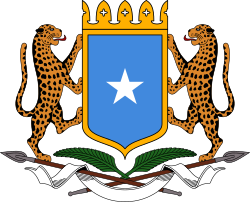 |
|---|
|
Parliamentary elections were held in Somalia on 30 March 1964. The result was a victory for the Somali Youth League (SYL), which won 69 of the 123 seats. [1] [2]
 |
|---|
|
Parliamentary elections were held in Somalia on 30 March 1964. The result was a victory for the Somali Youth League (SYL), which won 69 of the 123 seats. [1] [2]
The elections were the first to be held since the merger of British Somaliland and Italian Somaliland created Somalia in 1960. After the union the two territories' parliaments had merged, retaining the same number of seats as in the 1960 elections in British Somaliland and the 1959 elections in Italian Somaliland.
| Party | Votes | % | Seats | +/– | |
|---|---|---|---|---|---|
| Somali Youth League | 472,296 | 51.67 | 69 | −14 | |
| Somali National Congress | 186,208 | 20.37 | 22 | New | |
| Somali Democratic Union | 95,707 | 10.47 | 15 | New | |
| Somali Independent Constitutional Party | 80,173 | 8.77 | 9 | +4 | |
| United Somali Party | 7,552 | 0.83 | 1 | −11 | |
| Liberal Party of Somali Youth | 6,766 | 0.74 | 1 | New | |
| Somali National League | 4,354 | 0.48 | 1 | −19 | |
| Somali African National Union | 3,930 | 0.43 | 1 | New | |
| 13 other parties | 57,083 | 6.24 | 4 | New | |
| Total | 914,069 | 100.00 | 123 | 0 | |
| Source: Nohlen et al. | |||||